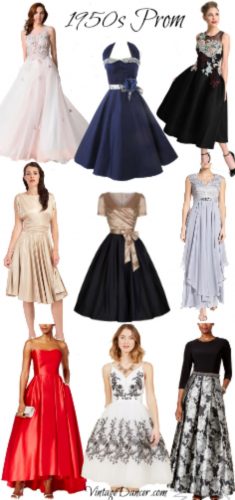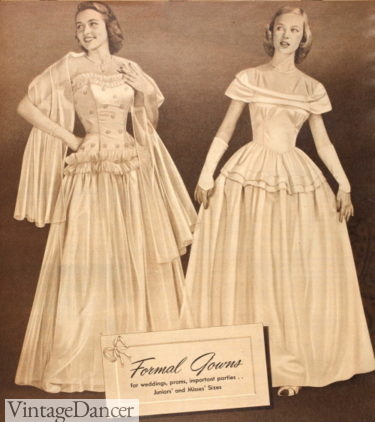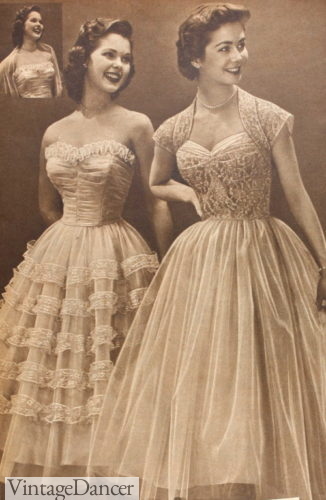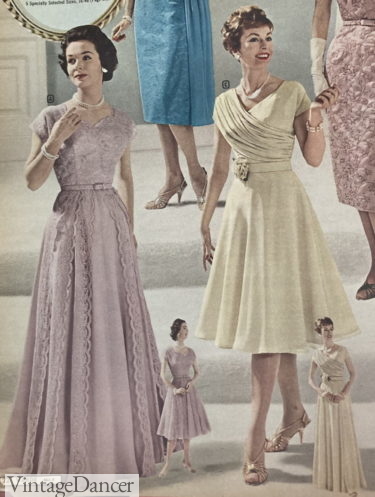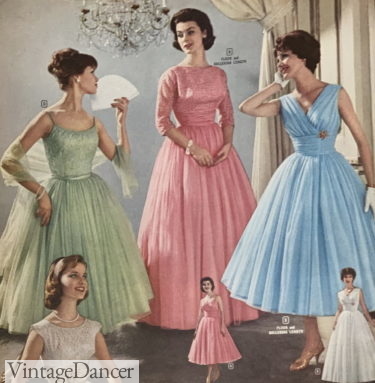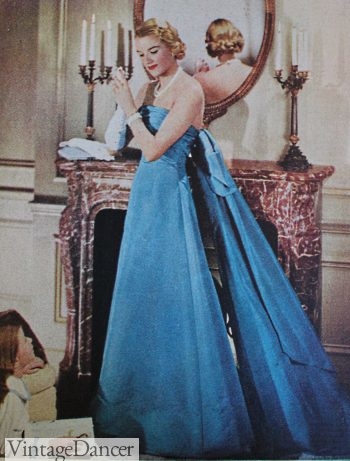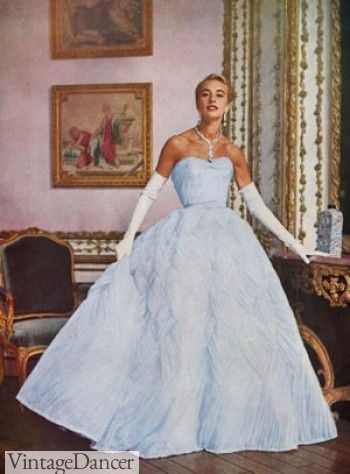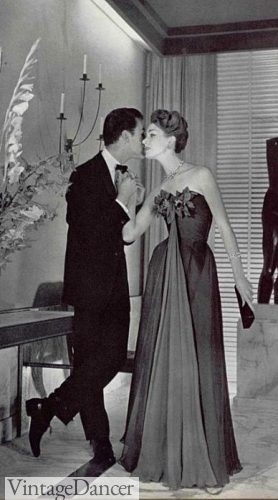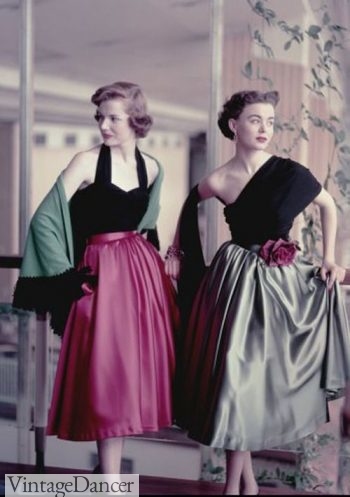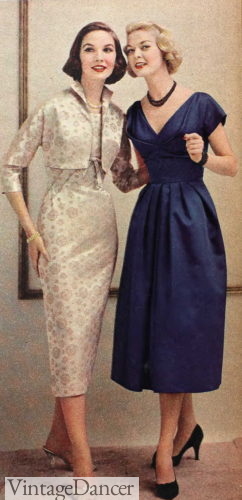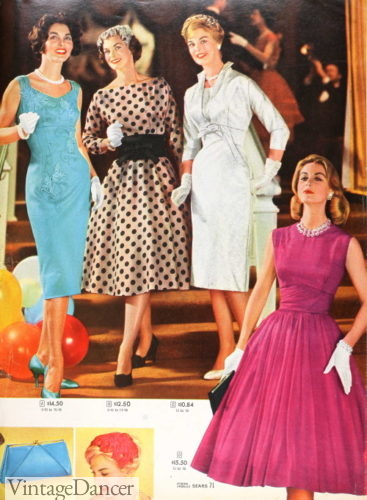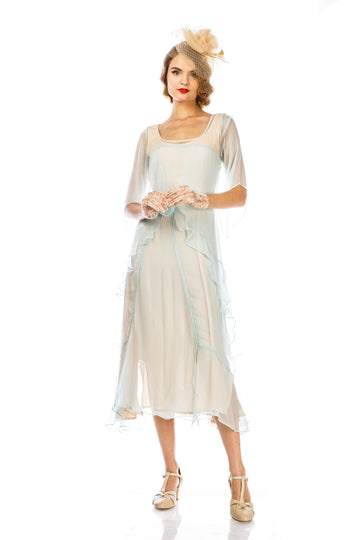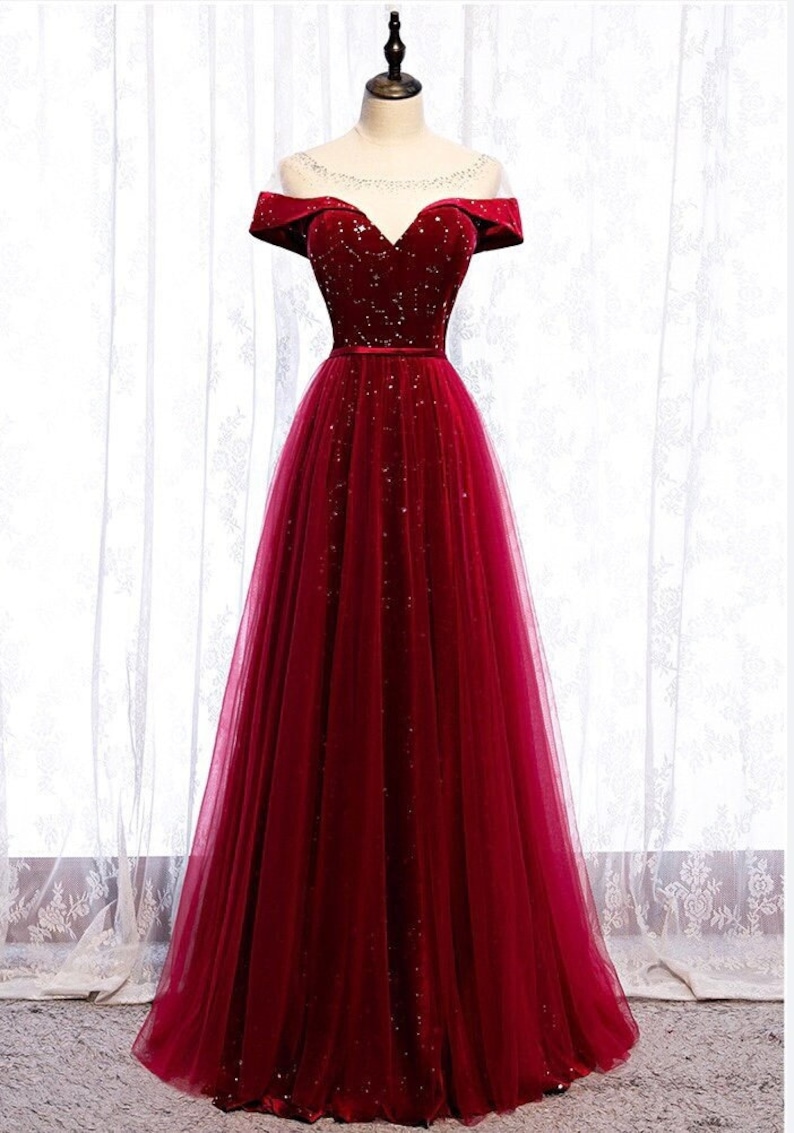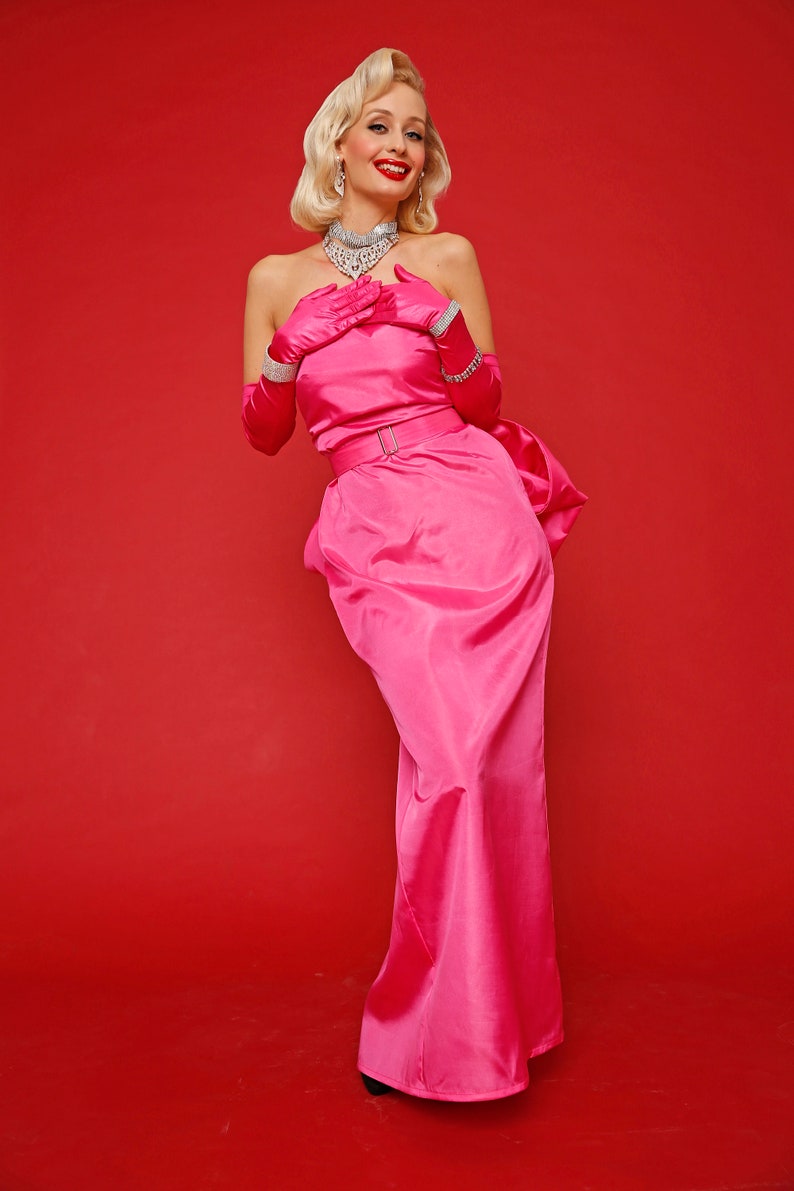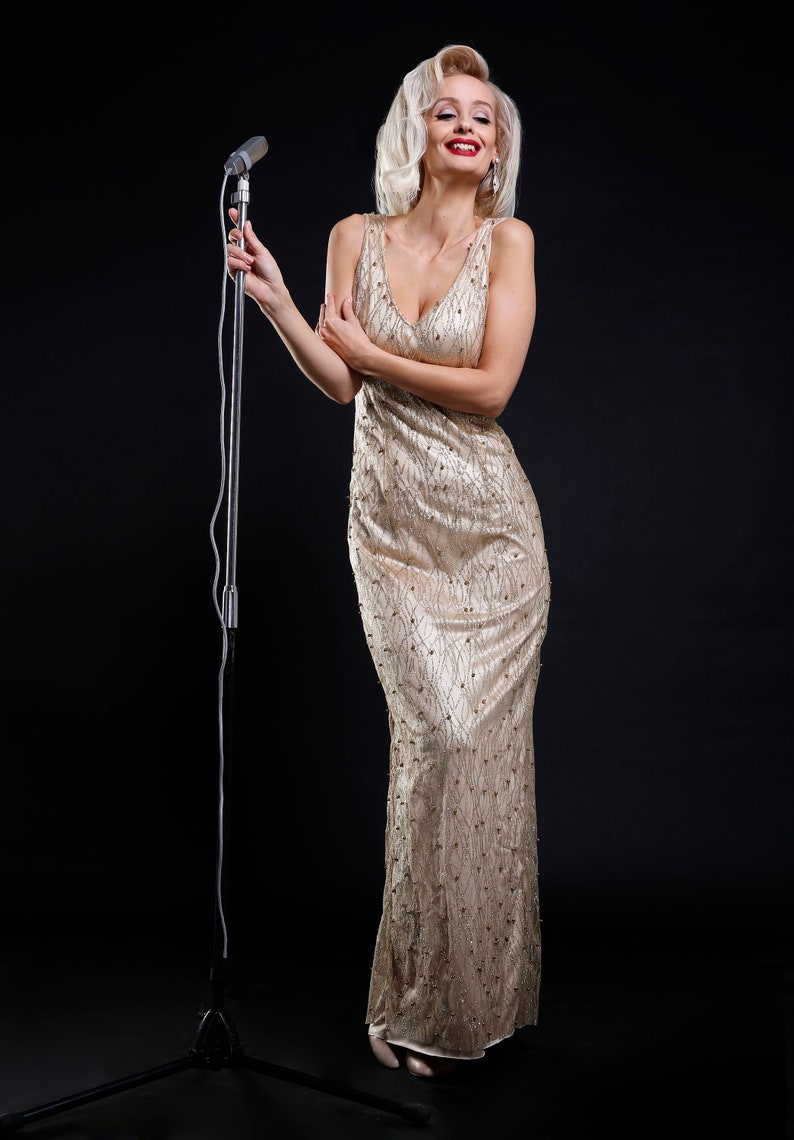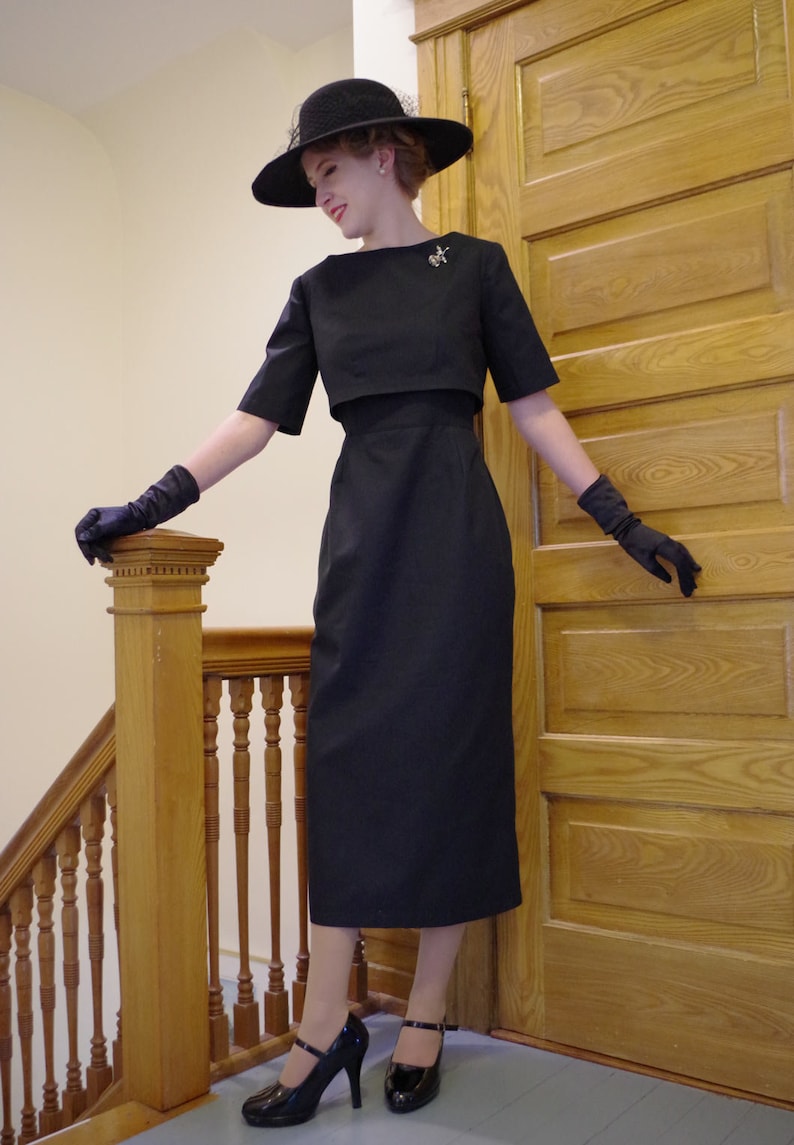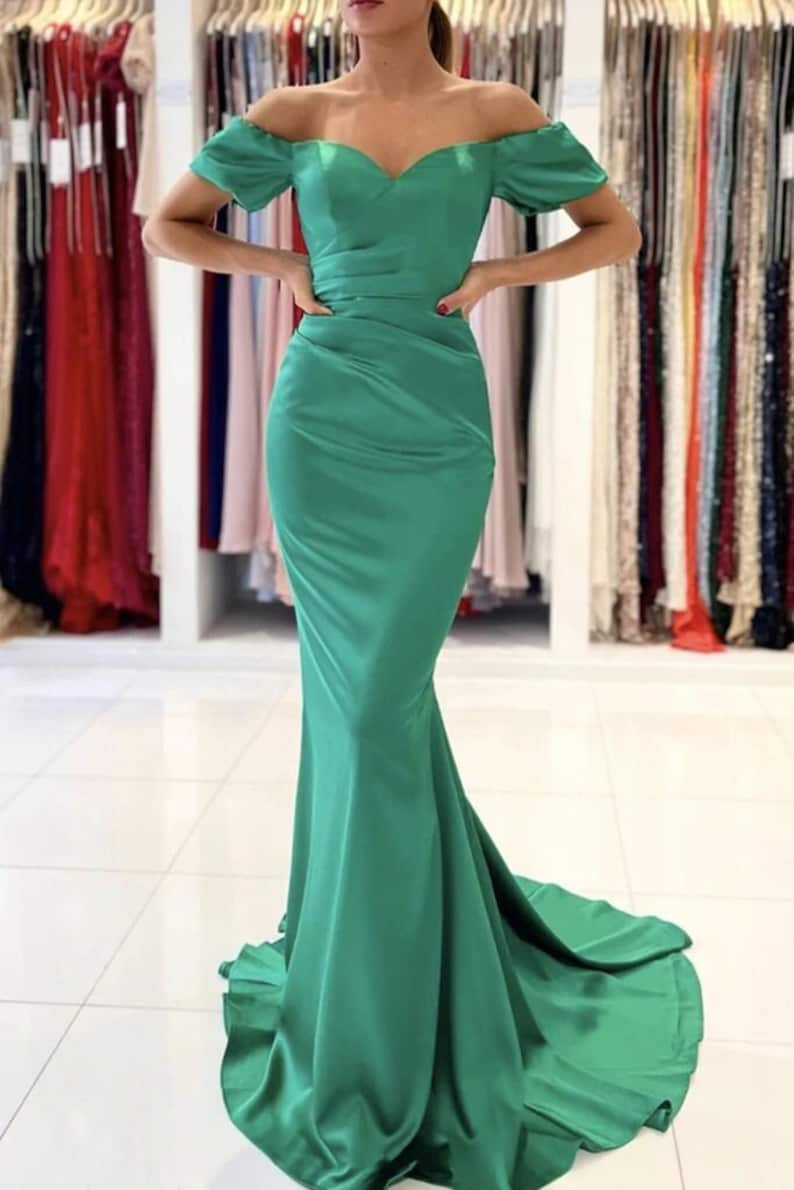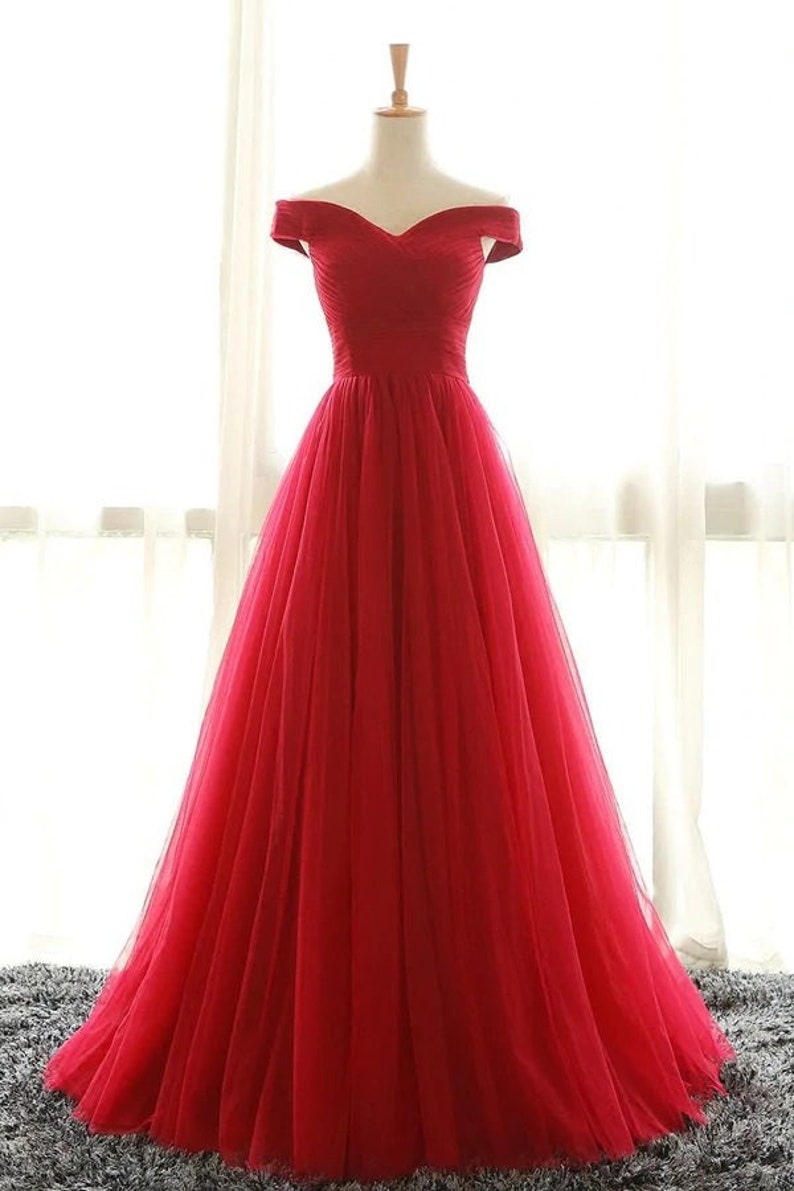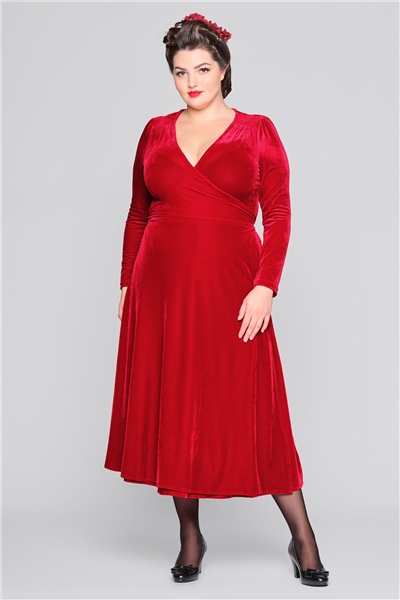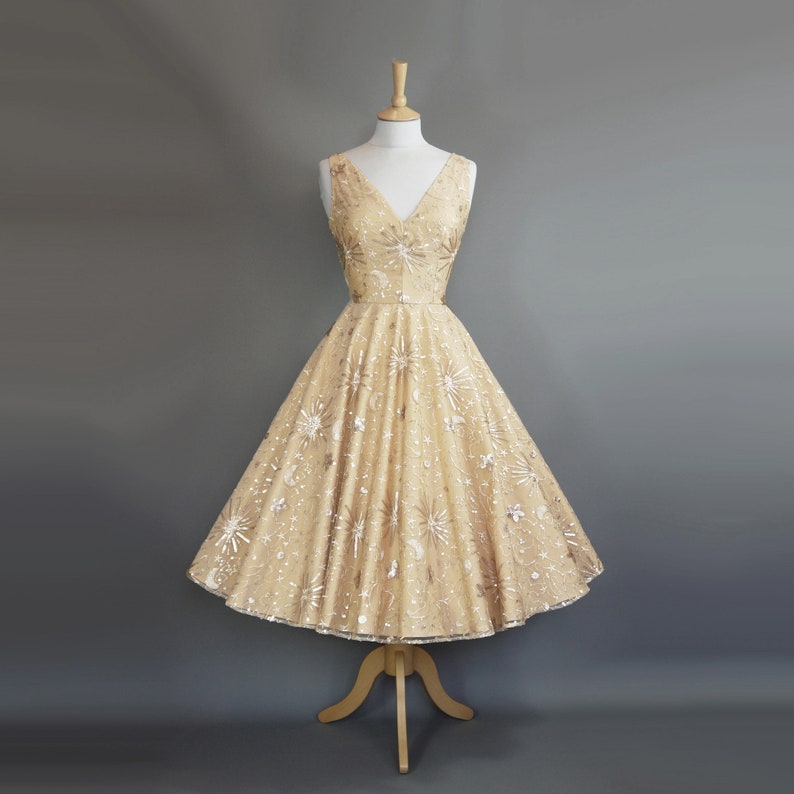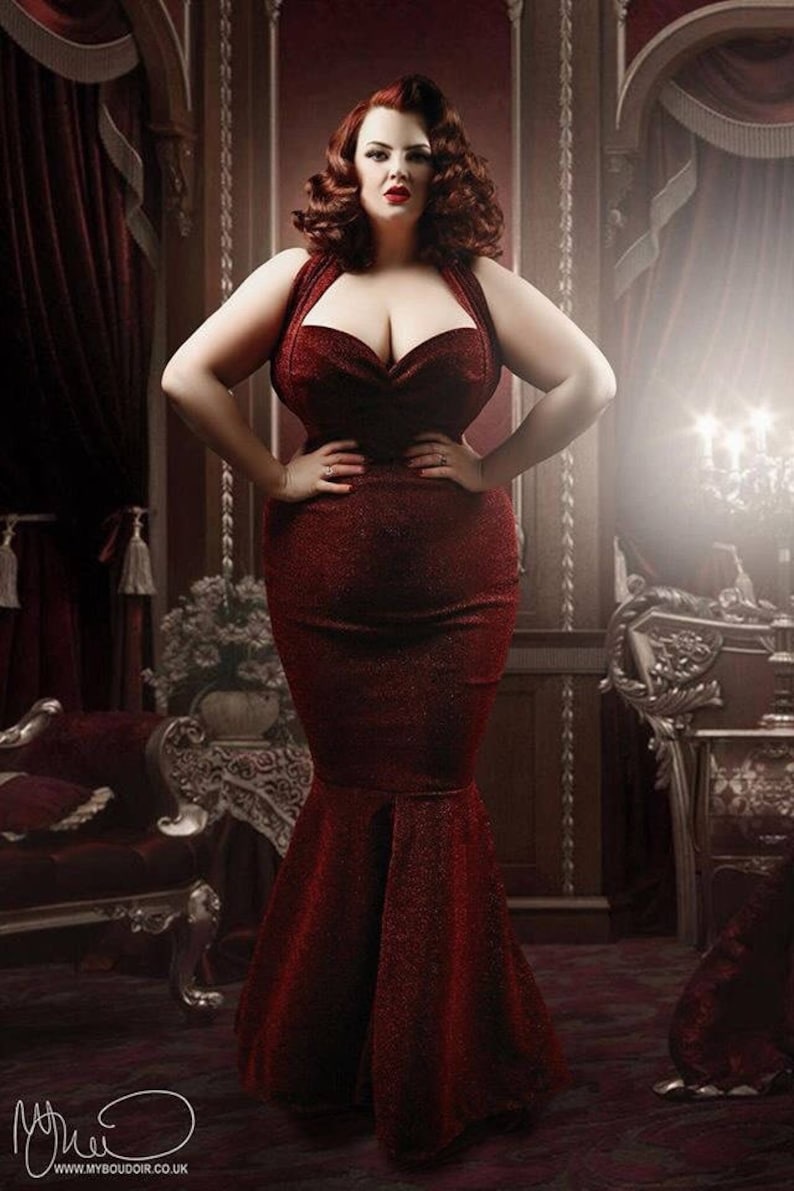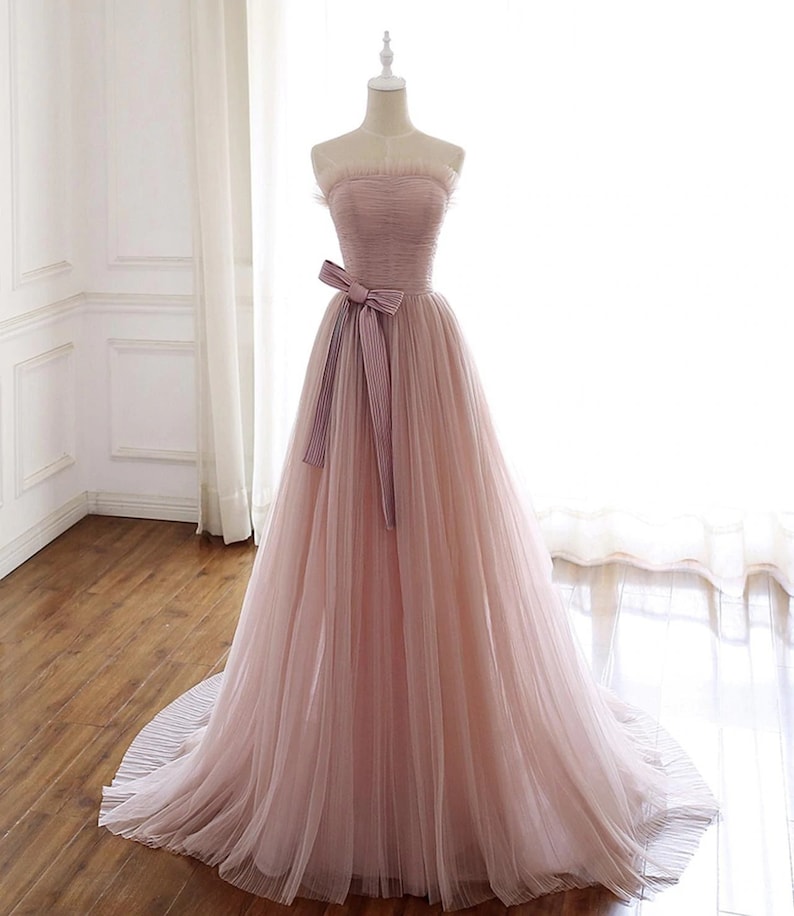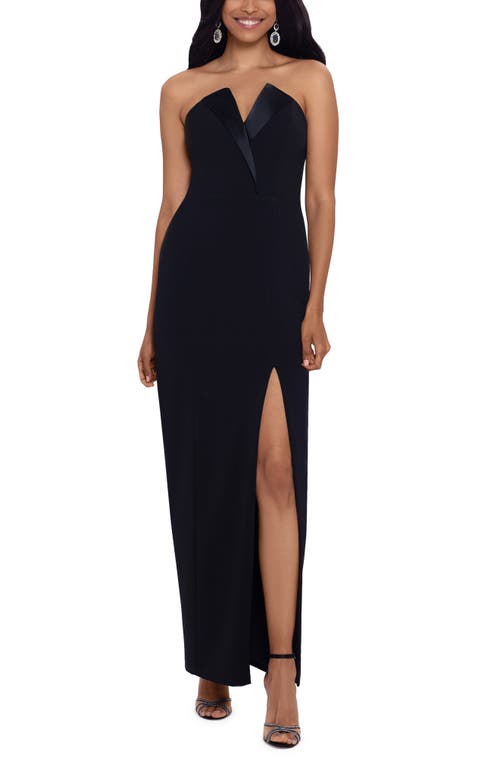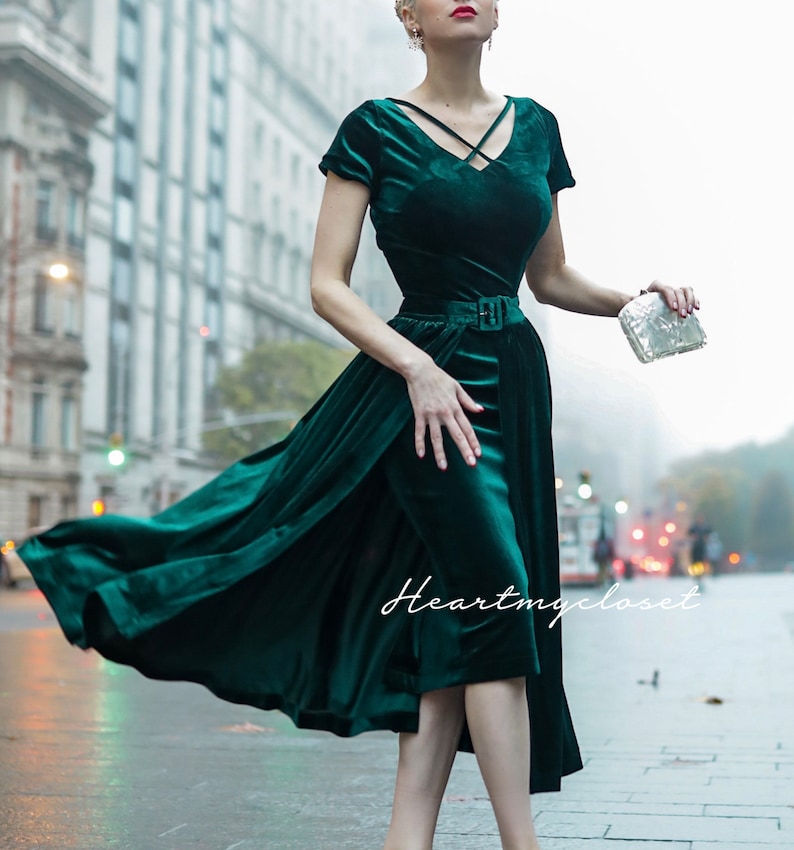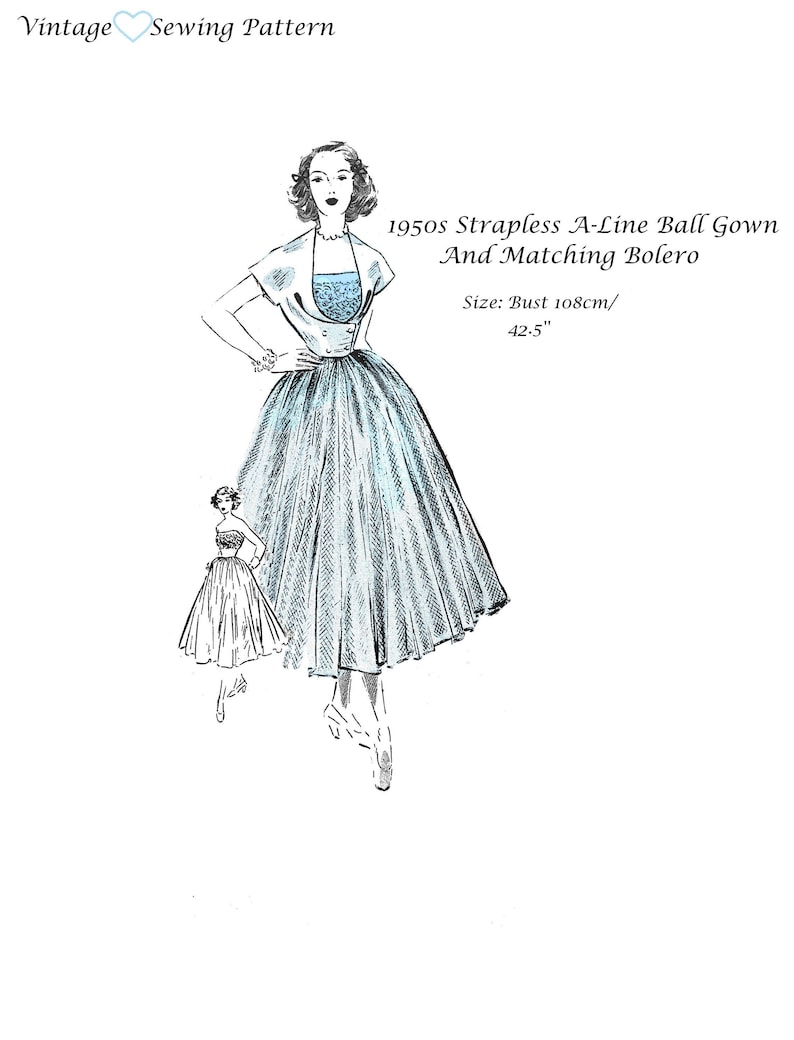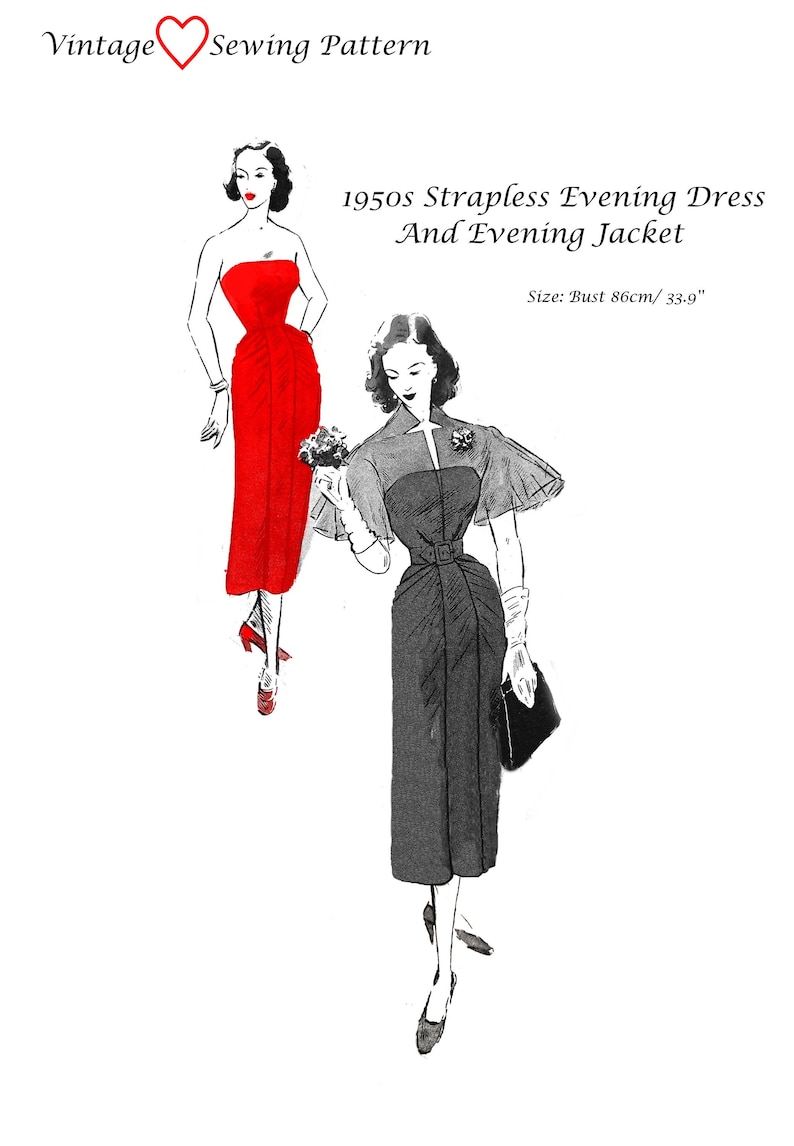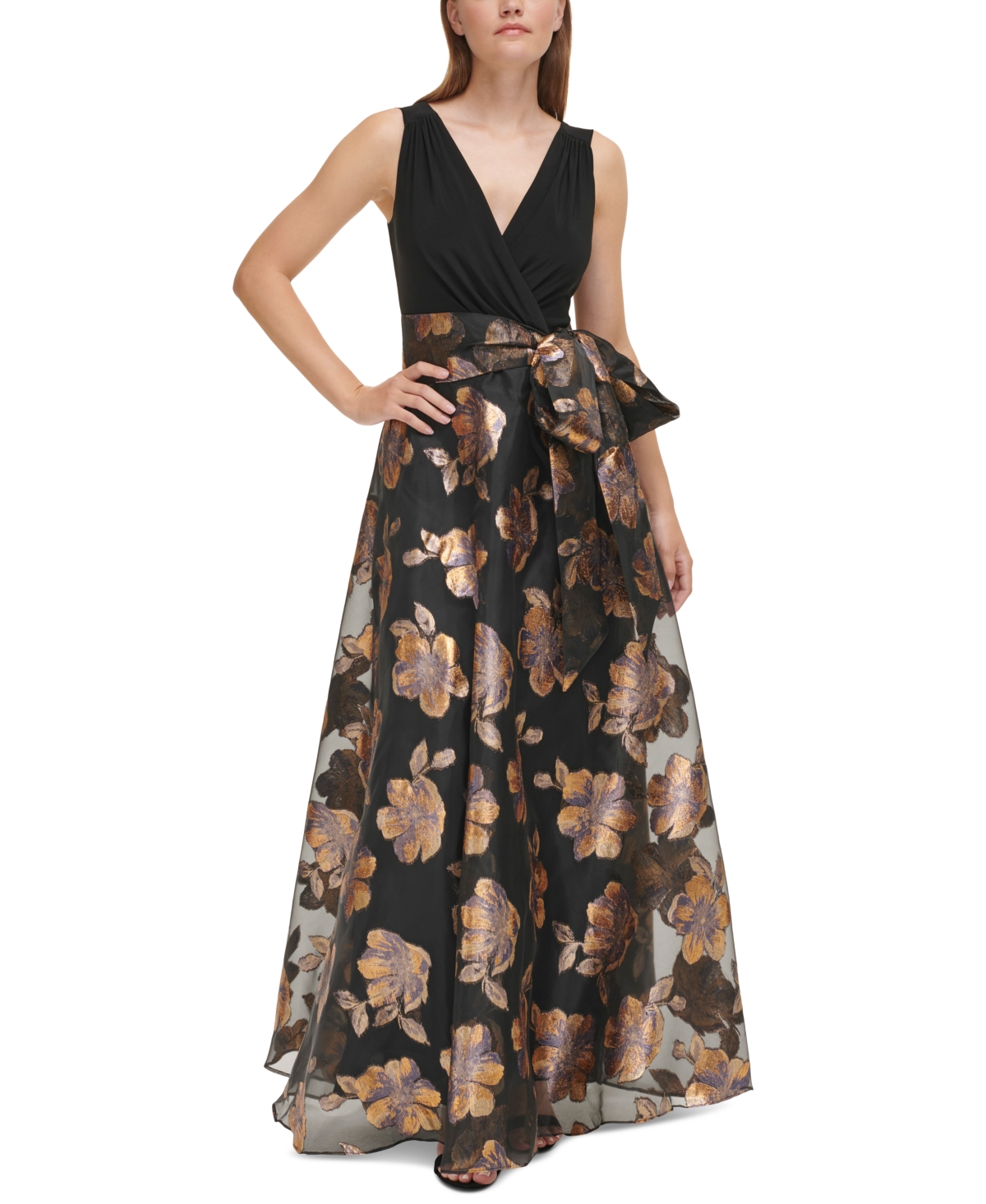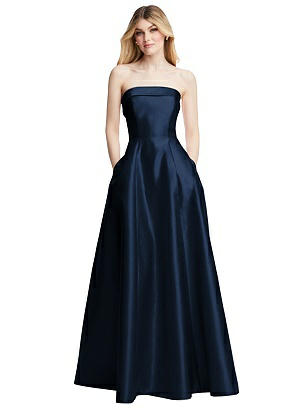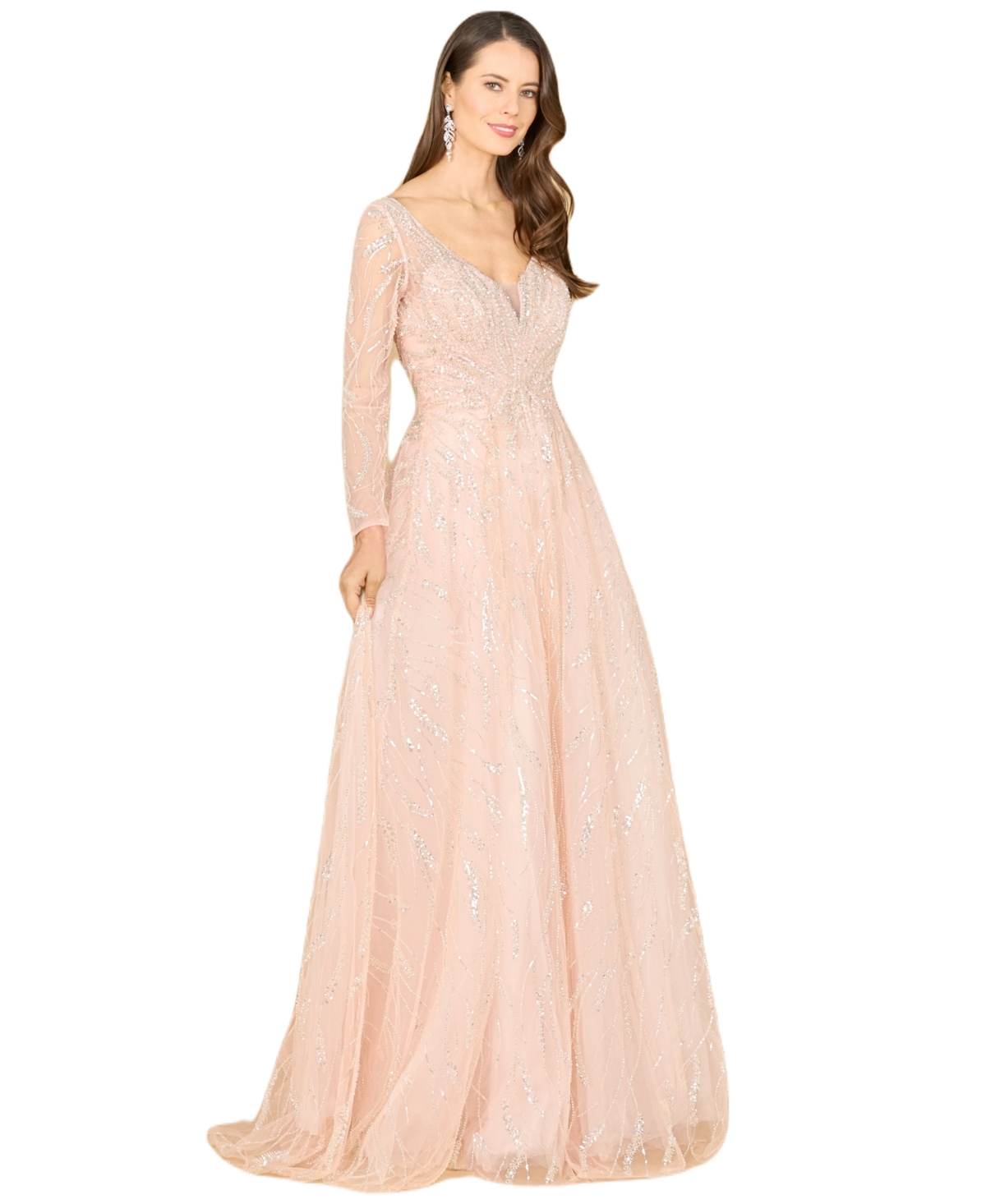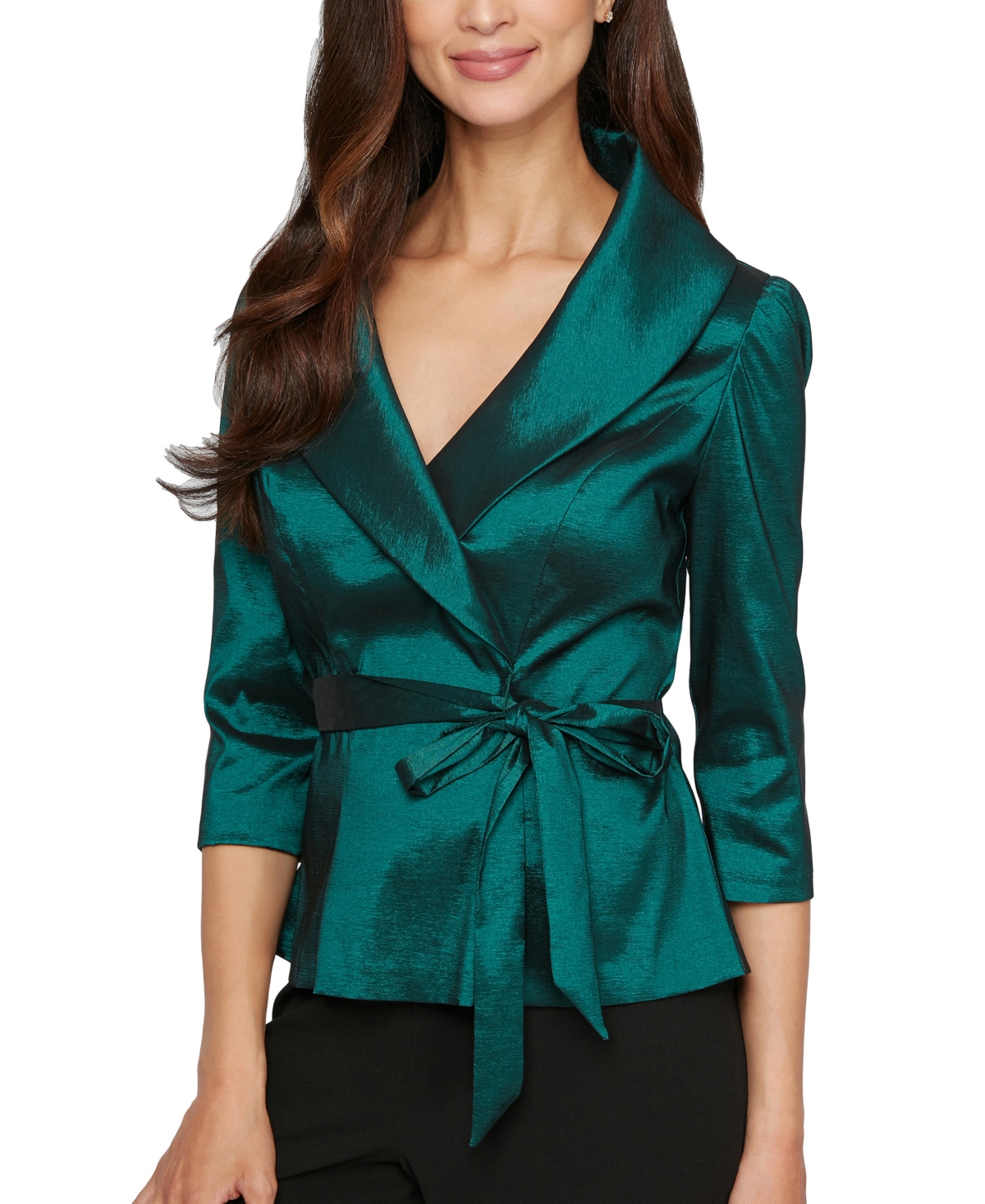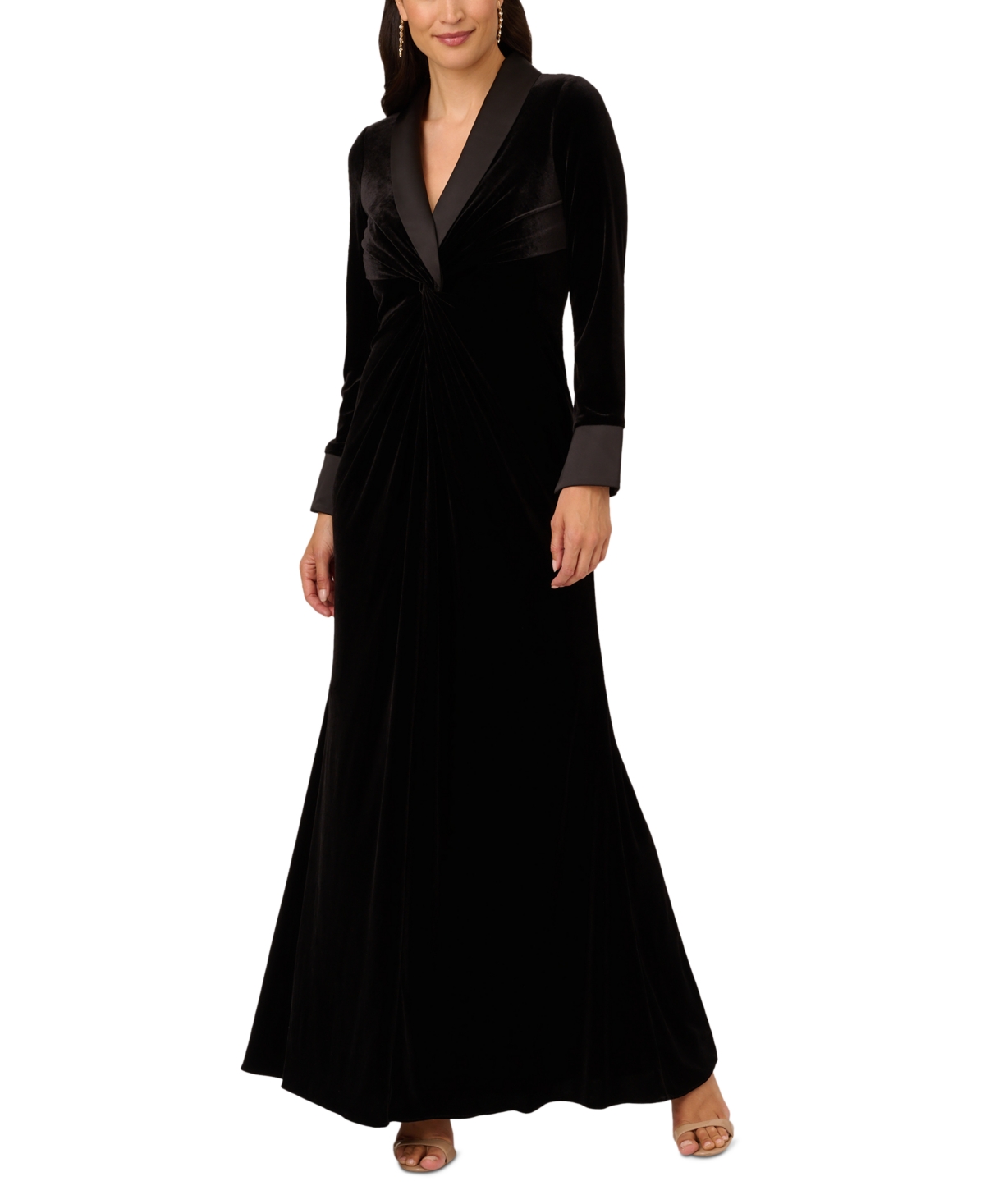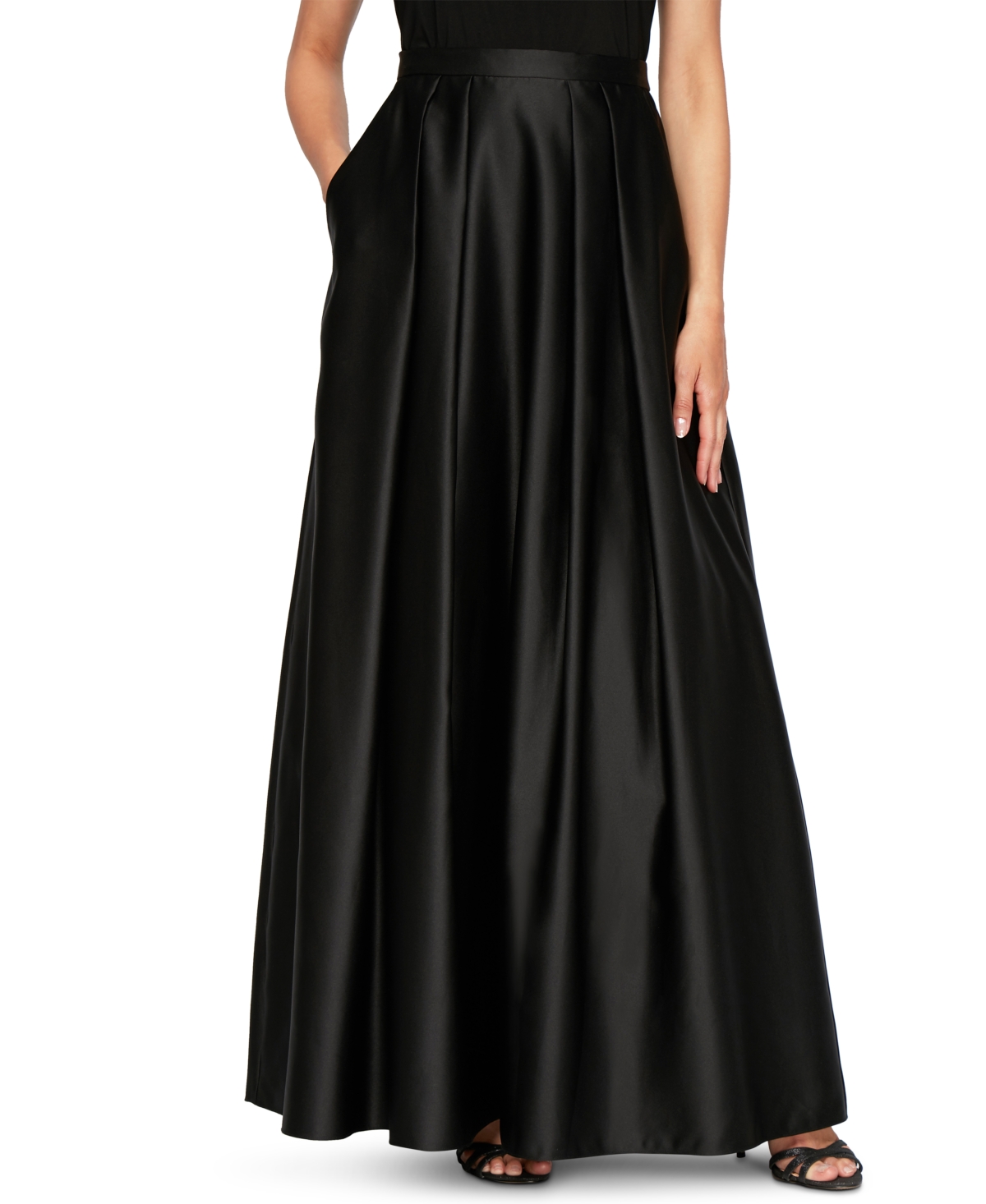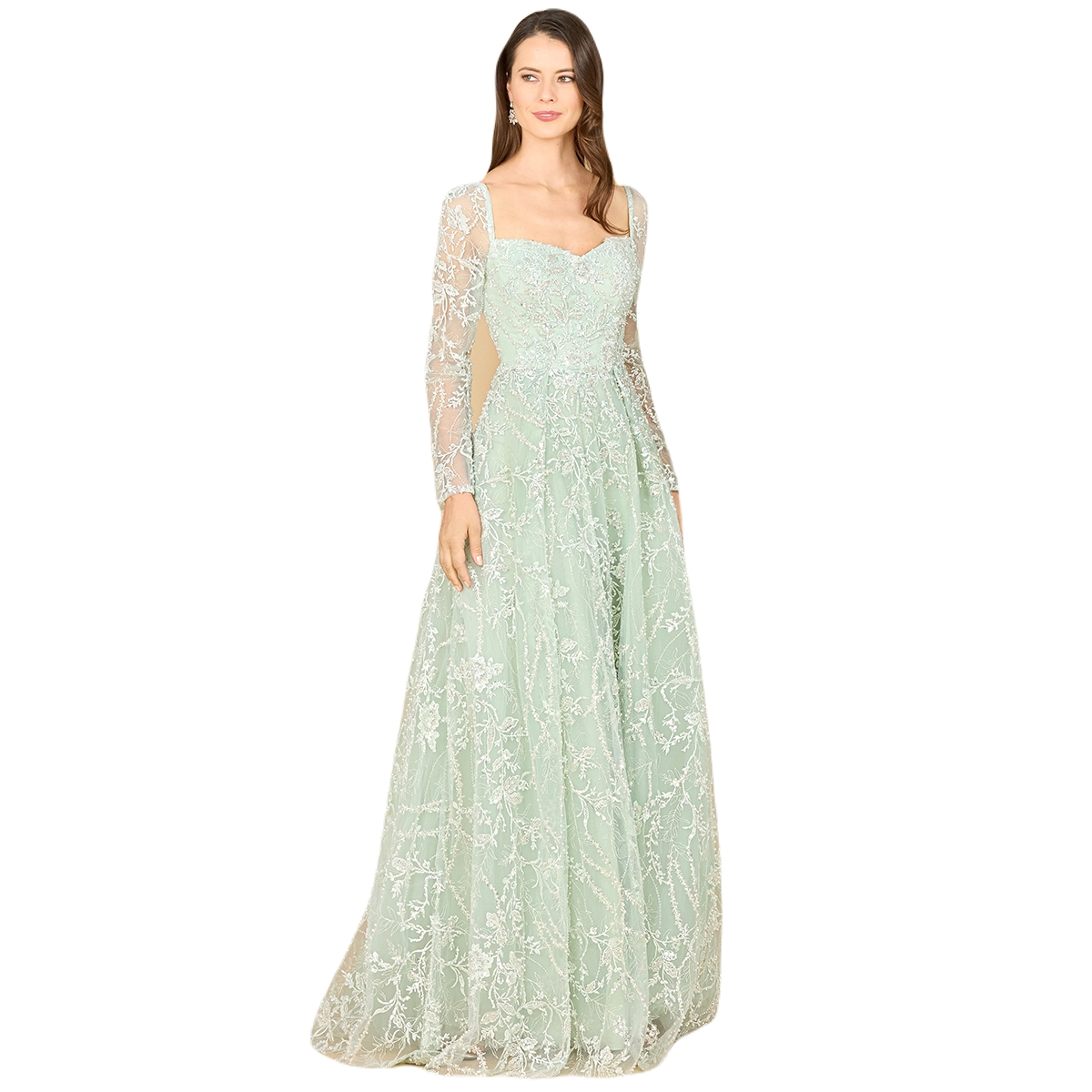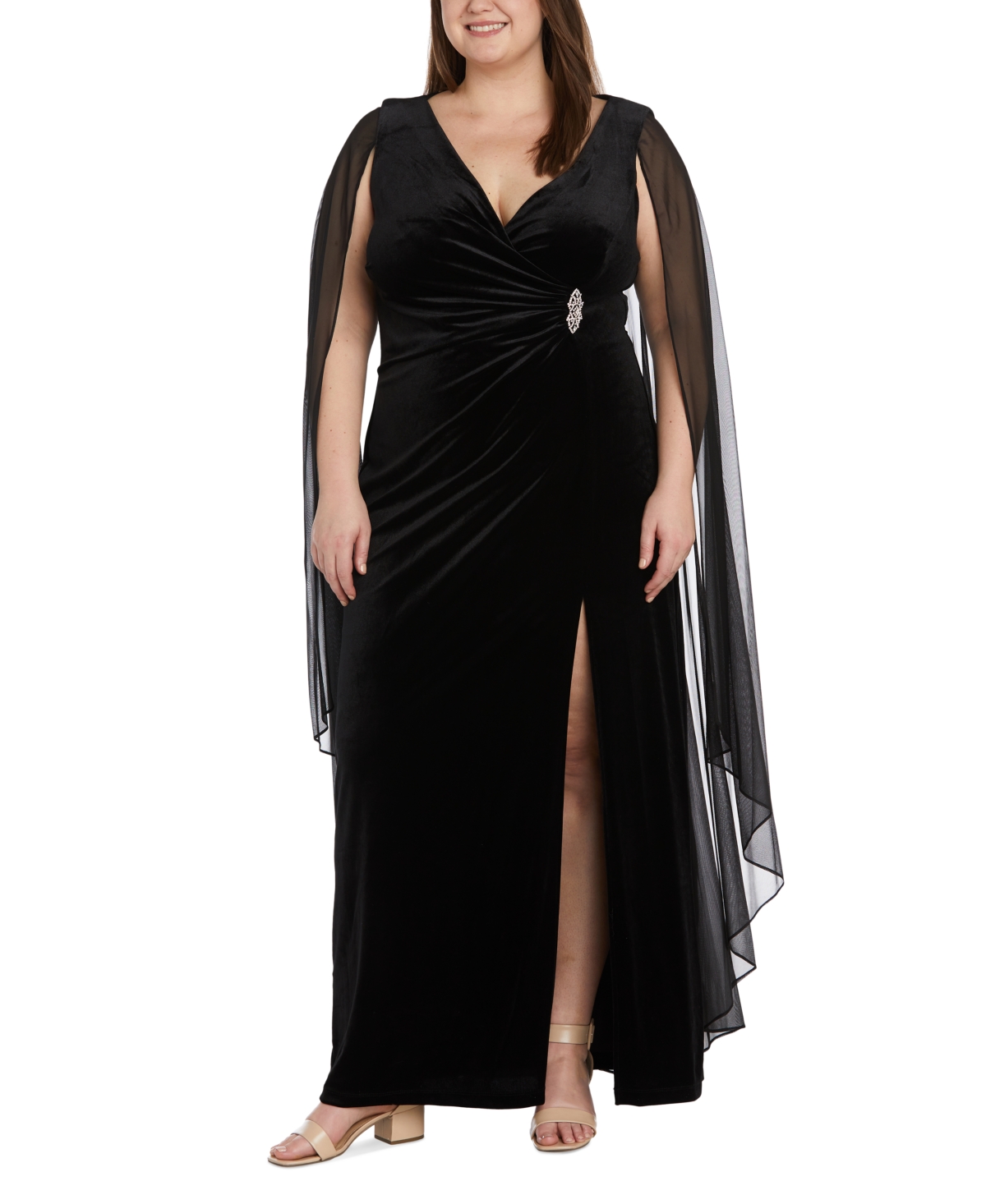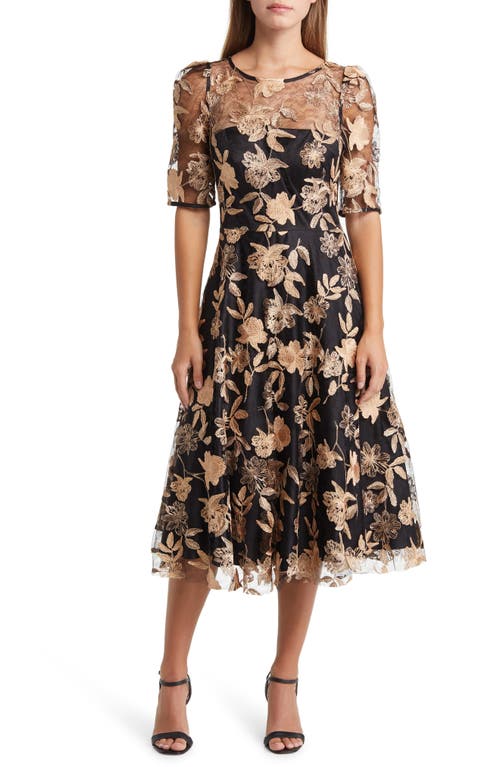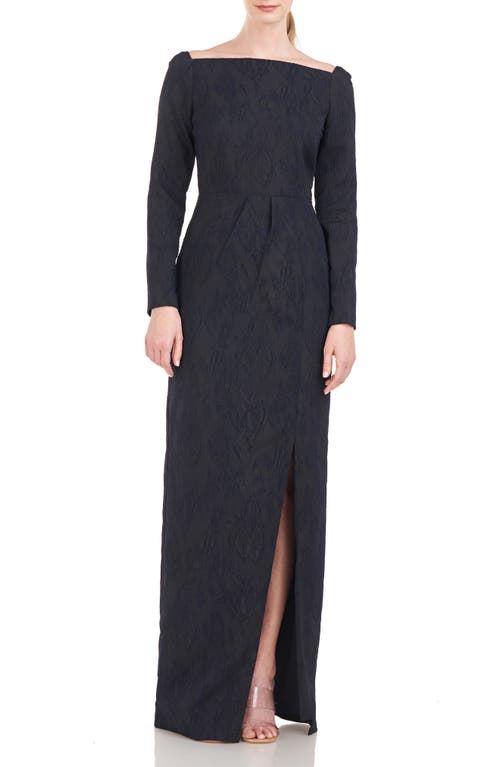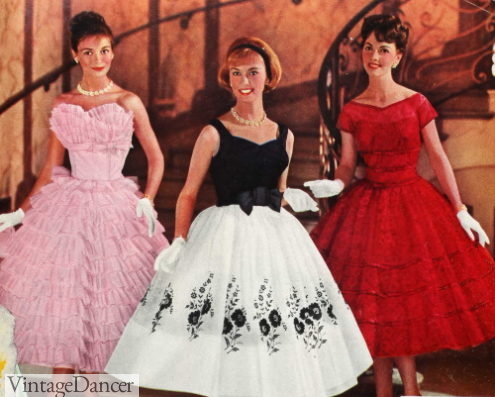
1950s formal dresses, evening gowns, cocktail party dresses and prom dresses were much like the popular dress styles of the 1950s. They accentuated waists with the-bigger-the-better length or tea length skirts, as that was all women wanted to wear. French designer Christian Dior’s “New Look” molded much of what we know today as 1950s fashion.
1950s Formal Dress Fashions
“Breasts were pushed up and spotlighted, waists were pared down to an anatomical minimum and hips were curved,” aka the hourglass figure.
The natural female figure was merely a starting block for the structure and design that clothing in the ’50s promoted. The look was innocent, romantic and glamorous — all which were the typical feminine ideal of the decade.
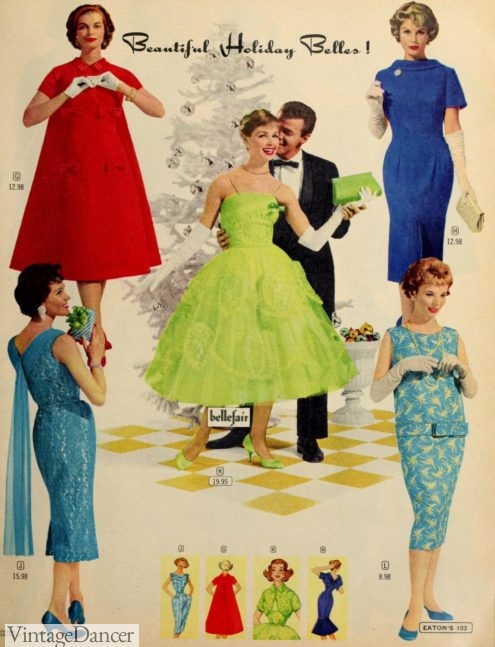
1958 cocktail party and evening dresses
The thin waist and extra large skirts were not a new invention in fashion history. Dior took inspiration from the mid nineteenth century Victorian Era when dress skirts, worn over several layers of hoops and petticoats, had a 160 inch (or more) circumference. Skirts this wide required 7-10 yards of fabric to make them full enough.
1950s evening gowns were made of silk, lace, tulle/net and decorated with flowers, beads, and embroidery. The growth of this fashion look was helped by the 1939 release of “Gone with the Wind.” The 1940s desire for a long gown with fuller skirts started the trend, while women in the 1950s (who had more money to spend) finished copying the look completely with the addition of hoops skirts and petticoats.
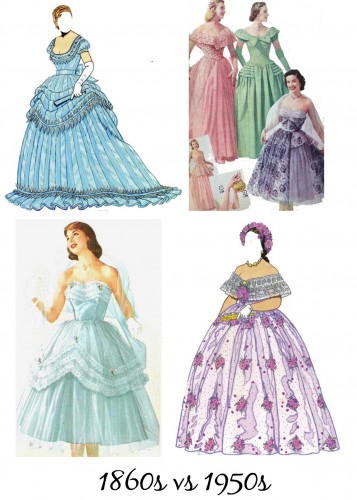
1860s ballgown inspired 1950s evening gowns
1950s Prom Dresses
“Conformity, thy name is teenager! The lesson here: bouffant hairdos, bouffant skirts, fussy, frilly, and oh-so-feminine,” reports the Dick Clark Company.
The 1950s prom dress was the most important dress the 1950s high-school girl was going to wear. It all came down to the perfect poof — and with popular colors ranging from one shade of pastel to another, it’s not hard to tell that femininity was all the rage. Going to prom was like going to the grand ball, and not just any dress would do….
- 1952 prom dresses
- 1952 tulle prom dresses
The popularity of Prom skyrocketed in the fifties, and American high school juniors and seniors were eager to get their fix of dance halls and rock music that the 1950s youth was sponsoring. Yearly proms were inspired by more formal debutante balls – including their style. Again, a tradition started 100 years earlier!
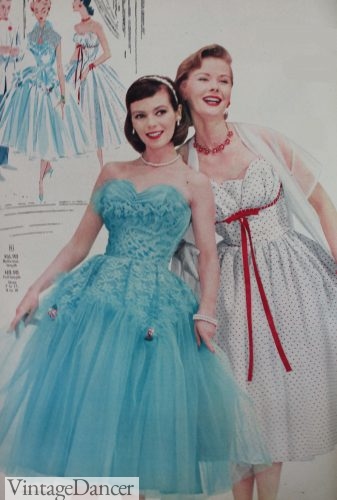
1956 teal blue and white/red dot prom dresses
When it came to the circumference of 1950s prom dress skirts, the sky was the limit. Traditional cotton and lace petticoats were insufficient, as the goal was to get as few slips as possible to stick out as far as possible. Endless layers of crinoline, nylon, lace, or paper net petticoats were added under dresses for support and volume.
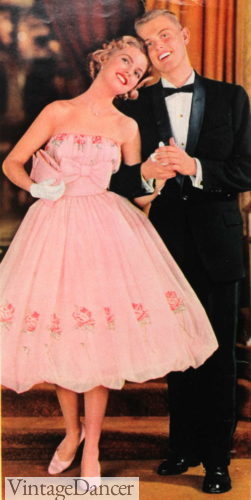
1957 pink prom dress
Petticoats were made sturdier by applying starch, and it was popular to have nylon horsehair braid sewn into the hem of your skirt to help get that perfect full look that young ladies desired. Hoop skirts could also be worn under dresses to ensure the right amount of volume, but there was also much difficulty when it came to walking, dancing and maneuvering around corners. But hey — we all have to sacrifice sometimes. Read more about the history of 1950s petticoats.
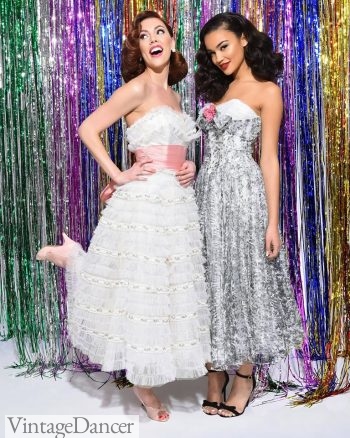
1950s inspired prom dresses at Unique Prom/ Unique Vintage
As with the times, prom dresses could be found endowed with intricate beading, sequins, ruffles, glitter, lace, appliqué detailing, and really any type of embellishment that would visualize the most grandiose dress that every teenage girl dreamt of. Glamor was first and foremost the priority when it came to prom. Dresses were fitted with yards and yards of tulle in the prettiest shades of pastels, ruffled accents, and velvet bows. The mindset must have been that if you thought you were going a bit over the top, there was always someone else going further.
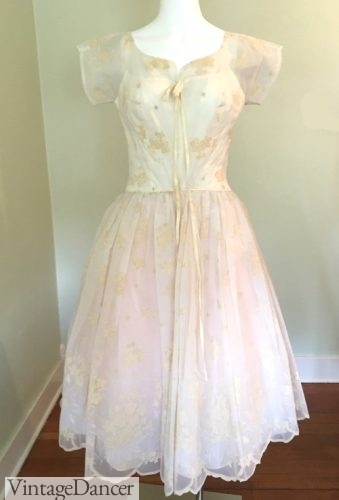
My mom’s Junior Prom dress made of flocked organdy
Women’s Evening Ballgowns
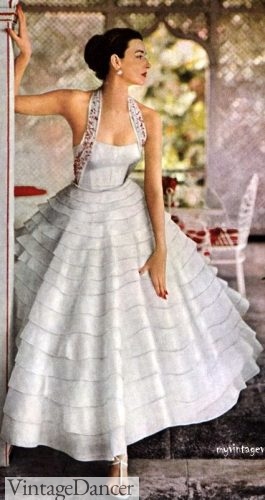
1953 white ruffles formal ballgown
The need to attend formal events was lessening during the 1950s decade. Usually, ball gowns were worn by women attending a charity fundraiser, opera, gala, or ball. The average woman had little need for an evening gown past high school prom.
Just like prom dresses, fancy-dress ball gowns were usually strapless with a tight waist, adding volume around the hips until the hem hit the floor. During the ’40s, dresses were simple with a narrow A-line ball skirt, and as we transitioned to the ’50s, evening dresses became much more elaborate, with a bigger circumference achieved with multiple layers of petticoats. Fluffier fabrics like tulle, organdy, and lace also added volume without weight, although mature women preferred taffeta, satin, or velvet gowns over “prom-like” princess gowns with not quite so much fluff. Skirts were either fuller A-lines or sweeping tea cups.
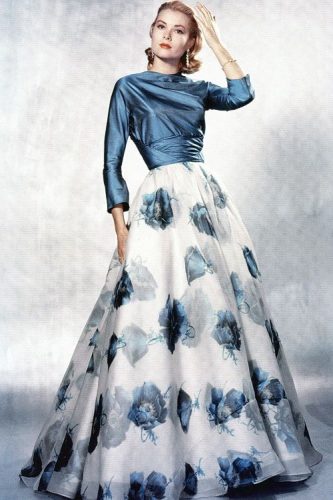
This gown Grace Kelly is seen wearing perfectly epitomizes the femininity and glamor of the 1950s floral gown.
Colors, too, leaned away from pastels and delved into richer jewel tones as well as classic black. Gold, silver, black, emerald, ivory, and red dominated the fall, while lighter shades of rose pink, violet, ice blue, mint, butter, and white entered in spring. Some summer styles were worn to garden parties or house parties, using large florals instead of a solid color. The flowers had an impressionistic feel to the print, making the dress appear light and airy even under 10 pounds of fabric and petticoats.
- 1959 lace and tulle long gown, satin cocktail dresses
- 1959 short and long tulle gowns
Draping, gathers, and large cascading bows added some architectural design to eveningwear. They were usually placed at the back of the gown to act as a high train, however placement at or under the bust was also an option. Women’s evening dresses usually featured any details or trim on the bodice with a simple full skirt on the bottom. The tight, strapless bodice accented the bust and shaped the waist with a built in corset. The Merry Window corselet with padded bra and low cut back became almost a requirement to wear with evening gowns.
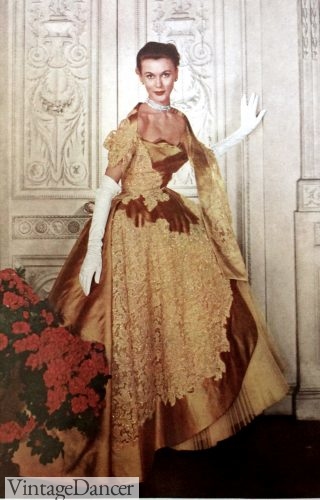
1954 Formal, Victorian inspired ballgown
To give some variety, a woman’s dress might have been tiered with lace, or had ruching in the bodice that cinched at the waist. Clusters of embroidery and sequins gave an extra bit of dazzle and matching accessories were a must. Modesty was very important in the fifties, and regardless of the style of the bodice of the dress, most women would wear a matching bolero jacket or shawl to cover her shoulders.
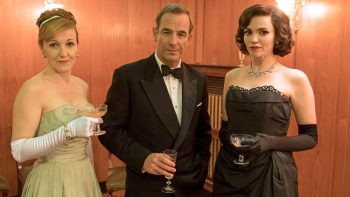
A scene from Grantchester with the ladies in ballgowns
- 1955 blue strapless ballgown
- Pierre Balmain ice blue gown, white cloves, statement necklace
- 1956 Grecian inspired column gown
- 1955 short evening dresses
The Long Slim Gown
A dress for mature women was the opposite of the big poofy dress. The sexy ankle length gown with straight neckline was immortalized by Marilyn Monroe in the 1953 movie Gentlemen Prefer Blonds. The slender tube gown first appeared in the late 1940s, but now in the 1950s it often had a big bow at the low back and a narrow belt at the waist. Costume designer William Travilla also designed a floor length sexy gold pleated tube gown with a deep plunging V neckline. It, too, was copied by the masses. Paired with matching long gloves, it was seductive and glamorous for a confident woman.
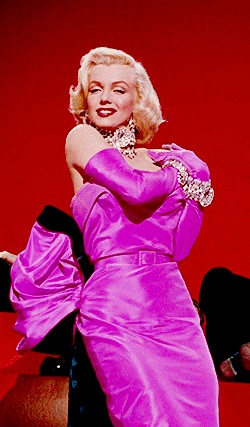
Monroe’s pink tube dress in Gentlemen Prefer Blonds
Many tube shaped gowns of the 1950s featured a full skirt at the back. The fullness on the backside counterbalanced the slimness in the front. From behind, she looked like she was wearing a ball gown, but whens he turned around — surprise!
Fullness at the bottom of a tube dress was another look. We would call it a mermaid style today. The 1950s version had a gathered skirt around the knees down to the floor. Some had a slightly shorter front and longer back train. Really daring gowns featured a tulle underskirt in a contrasting color such as white, pink or gold.
Almost all tube dresses were strapless with a straight or modest sweetheart dip. Those that did have straps placed them out to the shoulder tips like a Bardot neckline, or had two halter neck straps.
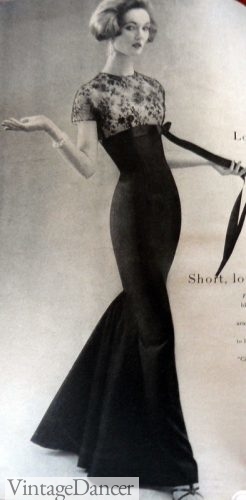
Long black mermaid skirt evening dress
Besides the tube gown, the Grecian inspired column gown remained a 1950s classic. It had long layers draped from the high empire waist down to the floor. It was simple, elegant and best of all flattering on most body types. It lacked the full skirt that made ball gowns heavy to wear, or the tight tube skirt that accentuated the body a bit too much for most modest women.
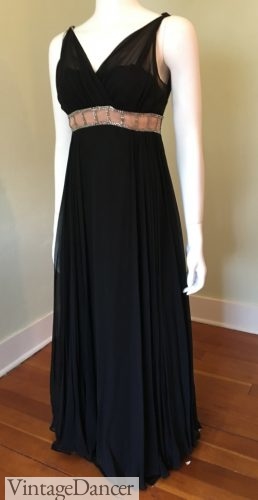
My 1950s black chiffon column dress with rhinestone embellished waist- it is divine to dance in!
1950s Cocktail Dresses
“We called them cocktail dresses, but we hardly drank.” – Anna Lee Fuchs, What We Wore
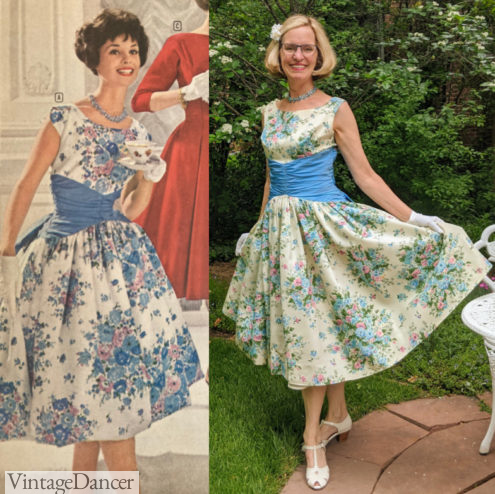
1959 Montgomery Wards floral party dress and an almost identical vintage dress worn by Susan R
In 1948, Dior named the early-evening dress the “cocktail dress.” From there, everyone was talking about and designing cocktail dresses that mimicked the silhouette of a tea length day dress but had the elegance and luxury of an evening gown. Most cocktail dresses had midi or long sleeves. Short sleeve or sleeveless dresses usually came with a matching bolero jacket or shrug. Necklines were somewhere between full modesty and a hint of cleavage.
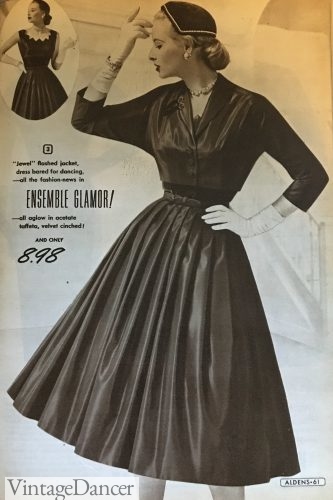
Black cocktail dress with bolero jacket and matching hat
Decorations were minimal, if any. Nine out of ten cocktail dresses were black. Those that were colored were usually bold and plain. Floral prints were welcome in summer. Velvet, taffeta, lace, and synthetics without shine were preferred. The bodice fit snug and ballooned out into a full skirt for the “New Look” style or a slender pencil skirt for women who had good legs.
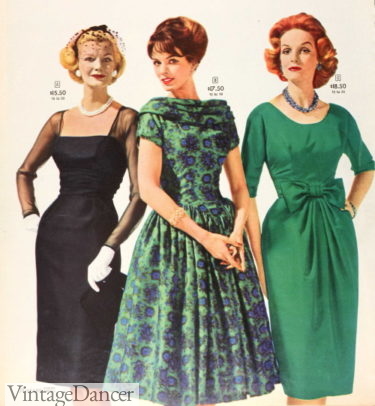
1959 cocktail party dresses
Black was the ultimate cocktail dress color. Every woman had one or two. They could be dressed up with pearls or dressed down with a colorful scarf. The merged well from day to evening and always made a woman look sophisticated.
- 1957 slim cocktail party dresses
- 1959 slim or swing party dresses
All cocktail party dresses were worn with matching shoes, gloves, and hats. Yes, hats! Wide brim hats were the most dramatic while small perch, crescent, or pill box hats were more tasteful at a home cocktail party.
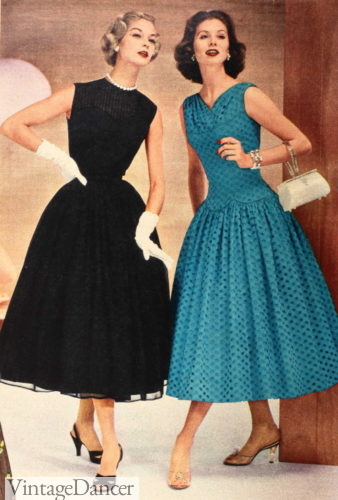
After 5 party dress with accessories (gloves, purse, jewelry, shoes)
Evening Dress Shoes and Accessories
Along with having the perfect dress, the right shoes were a must when it came to creating the right prom look. Pumps, dyed to match the dress, were ideal. Tall thin heels were very feminine. A young girl would wear as tall of a heel as she could manage (and her parents would allow). Shoes were made of leather, velvet, or satin with decorated toes and heels. Some had open peep toes and thin straps around the ankle, while the later years preferred pumps and mules (slip-ins). My mom wore clear plastic peep toe pumps with a low heel to her prom. They remind me of Cinderella’s glass slippers. Shop 1950s style shoes here.
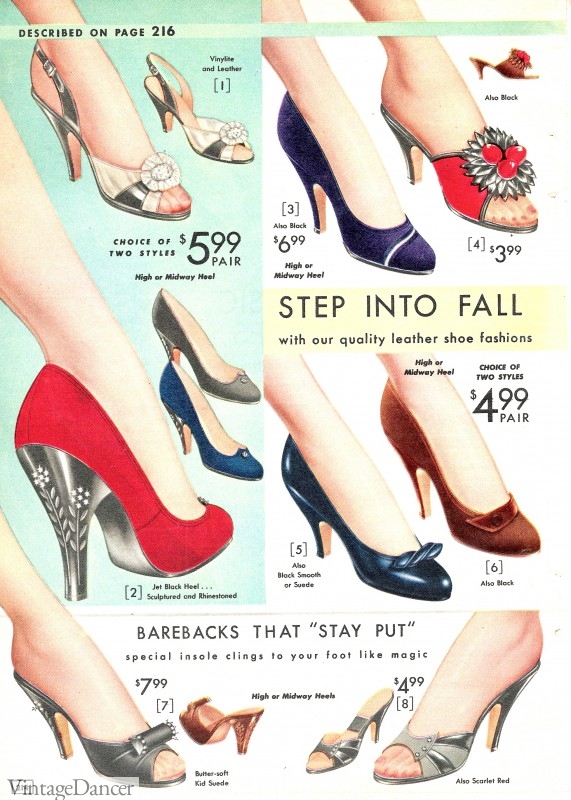
1957 formal shoes with fancy decorations
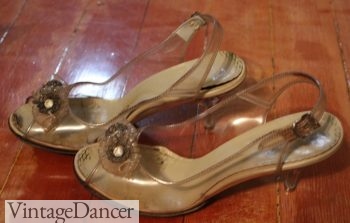
Mom’s 1950s clear plastic prom shoes (yellowed with age)
Stockings were a must wear, too. They had to be very sheer and nude. While black backseams were popular on nude tights, they would be out of place for a prom dress unless it was a black dress. For most pastel colors, nude stockings with nude seams were ideal. Now was also a great time to wear the less common seamless stockings. Learn more about 1950s stocking history here.
Of course, a ladies’ handbag had to match her shoes, as well as her nail polish and lipstick. Not a hair was out of place, but it was oftentimes decorated by a jeweled clip, flower or headband.
Gloves were also a frequent accessory due to their instant touch of glamor. 1950s Gloves could be wrist length with a ruffled lace, beaded or rhinestone cuff or over the elbow opera length mostly worn with floor length ball gowns. A large flower corsage was carried (not worn) by many girls.
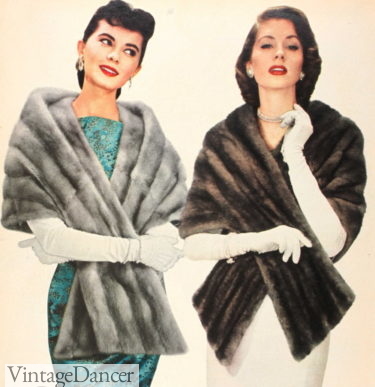
1956 fur wrap, jewelry and long gloves
Women and teens frequently wore stud earrings if they wanted something simple, or dangly-drop earrings for more of a statement. Choker pearl necklaces were all the rage, small dainty bracelets were always fun, and maybe a tiara was donned if she was crowned prom queen. Small accessories here and there gave that little bit of shine. Things like hair clips or broaches were often added as final touches to give that extra bit of sparkle. The idea was to be as sophisticated and glamorous as the movie stars, so any bit of jewelry would do that.
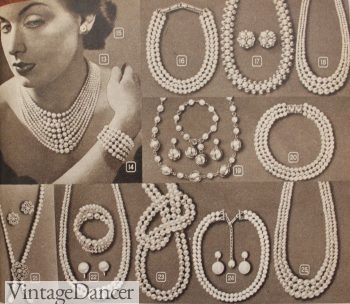
1951 Pearls were essential to a prom or party dress
Thanks to the end of the war and the restrictions it put on Americans financially, prom became elaborate and expensive, as did the styles. It was much more common than in previous years for girls to take shopping trips to find the perfect dress, shoes, and accessories. It was imperative to come to prom with the best-looking date, and being named to prom court guaranteed a high social status.
“What I chiefly remember about my clothes in the fifties is how formal they seemed. I have a picture of me in 1957, taken on my way to some get-together of senior high girls. If you can believe it, I wore white gloves and a string of pearls. Today such an event among my daughter’s friends would produce an entire roomful of blue jeans.” – Caroline Latham, What We Wore.
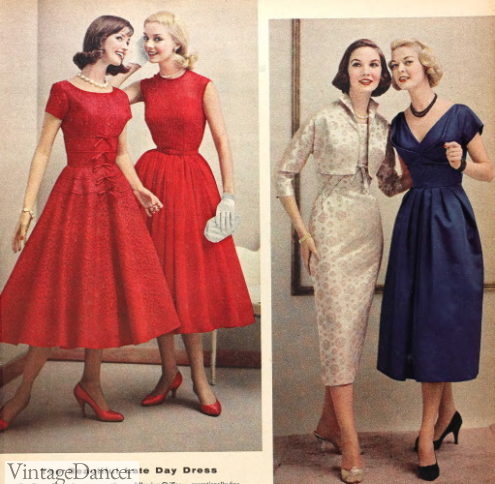
1957 party dresses
1950s Prom & Evening Dresses Today
If I were going to prom again in the 1950s style, I would certainly want to wear vintage. The one time I wore my mom’s cream color prom dress to a dance, everyone thought I had just gotten married! Never-mind other people, white, ivory, and gold tone prom dresses are so elegant. Pastel colors are also popular (pink anyone?) as well as brighter hues of teal, black and coral.
Vintage repro or inspired prom dresses are also very trendy right now. They lack the giant poof of vintage dresses, but still maintain the vintage look with layers of tulle, pastel colors and tea length or shorter style. For long ball gowns, try quinceañera dresses at your local Mexican party dress shop. Here are some of my favorite prom dresses online:
